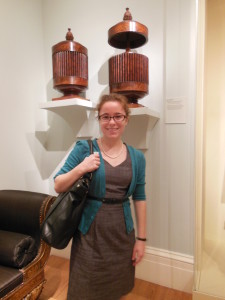Seeking American-made Knife Boxes
EMERGING SCHOLARS > SUMMER RESEARCH GRANTS
By Alexandra Parker
Smithsonian George Mason Program in the History of Decorative Arts
The focus of my masters thesis research is the documentation of the American cabinetmakers who manufactured knife boxes and extant examples of their work. My interest developed while giving tours of historic houses in Virginia where these objects are prominently featured and frequently draw visitors’ interest. These uncommon yet exquisitely crafted wares were fashionable and functional additions to a sideboard display in the late 18th and early 19th centuries. Although American production of this form paled in comparison to English imports, I have learned that American makers did not slavishly copy British sources. They often used unique designs or creative adaptations of what was being produced abroad.
My research was initially limited to local examples, such as those found in the Kaufman Collection now on view at the National Gallery of Art, but a summer research grant from the Decorative Arts Trust enabled me to travel extensively to examine knife boxes in New York City, Philadelphia, and Williamsburg. This in-person analysis has vastly improved my understanding of their construction, ornamentation, and function, and I am grateful for the Trust’s support of my research.
The Philadelphia Museum of Art was my first stop, where I was able to see two masterful sets of locally made knife boxes. The Museum’s extensive curatorial files alerted me to similar examples in other collections. At Colonial Williamsburg I had the opportunity to compare English- and American-made knife boxes side by side, which proved to be an instructive experience in learning about construction techniques and materials. My visit to the Metropolitan Museum of Art included an afternoon session with the five sets of knife boxes in the American Wing collection, which represent a broad variety of designs available in the early 19th century, as well as the options for the flatware cutouts inside.
The perspective I gained from my travels will result in a vastly improved and more in-depth analysis of knife boxes for my thesis. Furthermore, I have now identified over 25 American cabinetmakers who produced the form and more than 30 American-made examples that survive today in public and private collections. In addition to creating a comprehensive history of the knife box’s use, design, and production in the United States, I hope to encourage other decorative arts scholars to reexamine specialized furniture forms that have been neglected.
SAVE THE DATE
- Special Symposium
“Classical Splendor”
The Philadelphia Museum of Art
November 4, 2016 - New York Antiques Weekend
January 20-21, 2017 - Spring Symposium
Savannah
April 21-24, 2017 - Spring Study Trip Abroad
Scotland
May 14-22, 2017 - Fall Symposium
Hartford & Western Connecticut
September 2017 - Fall Study Trip Abroad
Venice and the Veneto
October 9-16 and 22-29, 2017
By Alexandra Parker
Smithsonian George Mason Program in the History of Decorative Arts
The focus of my masters thesis research is the documentation of the American cabinetmakers who manufactured knife boxes and extant examples of their work. My interest developed while giving tours of historic houses in Virginia where these objects are prominently featured and frequently draw visitors’ interest. These uncommon yet exquisitely crafted wares were fashionable and functional additions to a sideboard display in the late 18th and early 19th centuries. Although American production of this form paled in comparison to English imports, I have learned that American makers did not slavishly copy British sources. They often used unique designs or creative adaptations of what was being produced abroad.
My research was initially limited to local examples, such as those found in the Kaufman Collection now on view at the National Gallery of Art, but a summer research grant from the Decorative Arts Trust enabled me to travel extensively to examine knife boxes in New York City, Philadelphia, and Williamsburg. This in-person analysis has vastly improved my understanding of their construction, ornamentation, and function, and I am grateful for the Trust’s support of my research.
The Philadelphia Museum of Art was my first stop, where I was able to see two masterful sets of locally made knife boxes. The Museum’s extensive curatorial files alerted me to similar examples in other collections. At Colonial Williamsburg I had the opportunity to compare English- and American-made knife boxes side by side, which proved to be an instructive experience in learning about construction techniques and materials. My visit to the Metropolitan Museum of Art included an afternoon session with the five sets of knife boxes in the American Wing collection, which represent a broad variety of designs available in the early 19th century, as well as the options for the flatware cutouts inside.
The perspective I gained from my travels will result in a vastly improved and more in-depth analysis of knife boxes for my thesis. Furthermore, I have now identified over 25 American cabinetmakers who produced the form and more than 30 American-made examples that survive today in public and private collections. In addition to creating a comprehensive history of the knife box’s use, design, and production in the United States, I hope to encourage other decorative arts scholars to reexamine specialized furniture forms that have been neglected.

